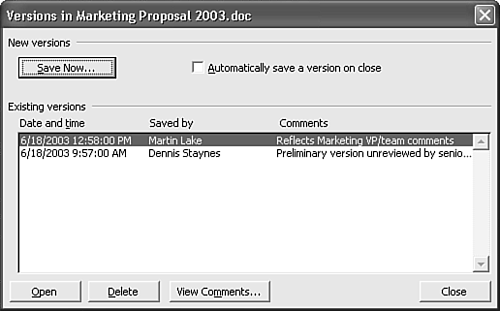Using Word's Versioning Feature
Many Word users are in the habit of using File, Save As to save a new copy of every new draft they create. By doing so, they not only make sure of having a recent backup in the event of disaster, but also create an audit trail that helps identify when a critical change was made in case it is questioned later.
Nothing has changed the need for storing backups, but Word now has a more convenient, reliable way of providing that audit trail. You can now store each new version of your document in the same file so that older versions can't get easily lost, misplaced, or confused with the current version.
Follow these steps to save a new version of an existing file:
Choose File, Versions.
The Versions dialog box opens.
Click Save Now. The Save Version dialog box opens (see Figure 26.23).
Figure 26.23. In the Save Version dialog box, enter detailed comments about why this draft was created and/or whose comments it reflects.

Enter comments on the version, such as whose changes it reflects, or why the new version was created. (Don't worry about entering the current date and time, or your own name?Word has already done that for you.)
Click OK. Word saves a new version of the document in the same file as the original.
CAUTION
If you save a file containing multiple versions using a format other than the current Word format, the older versions will be lost. If you need to save the current version in an older format, first use File, Save As to make a copy of the file; then resave the copy in the older format you need. All the versions will, of course, remain in your original file.
NOTE
In a file containing multiple versions, Word's document statistics apply to the current version only.
Working with Multiple Versions of a File
After you've created one or more additional versions of a file, a Versions icon appears at the far right of the status bar (see Figure 26.24).
Figure 26.24. The Versions icon in the status bar indicates that a file contains multiple versions.

To work with your versions, you can double-click this icon, or choose File, Versions. This reopens the Versions dialog box. In Figure 26.25, you can see how this dialog box looks after multiple versions of a document have been created.
Figure 26.25. The Versions dialog box provides several new options after you have versions from which to choose.

To open any version, select it and click Open. To delete an old version, select it and click Delete; Word asks you to confirm the deletion and reminds you that you can't undo this action.
TIP
If you're planning to send a document out for review, you may want to delete all old versions to make sure that reviewers see only the current one. (Or, better yet, use File, Save As to create a new copy of the file and then delete the unwanted versions from the copy only.)
In the Versions dialog box, you can already see the first few words of comments about the file; if you want to see more, click View Comments. You can't edit comments made about a version that was saved previously; the comments are read-only.
Saving a Version as a Separate File
When you open an older version of a file, Word displays the document in a separate editing window, which splits the screen as shown in Figure 26.26. Notice that the version you opened has a save date in its title bar?a gentle reminder that you're not working with the current version.
Figure 26.26. If you open an older version, Word displays a new editing window and displays the version's creation date in the title bar.

If you make changes to the older version, Word won't save it in the same file any longer. When you choose Save, Word displays the Save As dialog box and shows the filename as it appears in the title bar with the version creation date. When you click Save, you get a new file containing only the version you edited.
TIP
Unfortunately, you can't use Word's Compare Documents feature to compare two versions of a document within the same file. You can work around this limitation, however, by saving each version you want to compare as a separate file and then choosing Tools, Compare and Merge Documents.

Automatically Saving New Versions
You may want to save a "snapshot" of your document each time you (or another editor or reviewer) finishes working with it. To do so choose File, Versions, and in the Versions dialog box, check the Automatically Save a Version on Close check box.
Versioning and Web Pages
Versioning is not available if you are editing a Web page. In addition, if you save an existing file in HTML (Web page) format, only the current version appears in the new HTML file. Word warns you that the older versions will be lost and offers to create a backup copy. Click Continue to save the backup copy and create a new Web file with only the current version.







